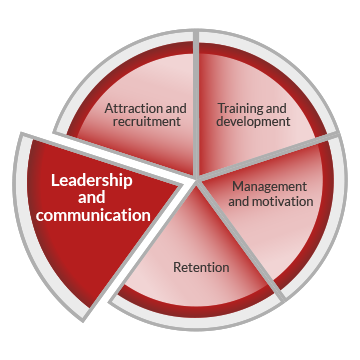High calibre leadership and communication skills, including the ability to apply effective workforce development strategies, are important ingredients for the overall success of your business.
Effective leaders have the ability to create an environment in which employees enjoy working and are productive. Your ability to achieve this depends on the leadership and communication methods you choose when dealing with your employees, together with effective management skills, including the implementation of robust workforce development strategies.
Leadership is team-based behaviour, not about individuals … leaders are captain-coach leaders, building the business from within. They are passionate, consistent in behaviour and they walk the talk.
(Hubbard, G, Samuel, D, Heap, S and Cooks, G 2002, The First XI: Winning Organisations in Australia, Wiley, Milton)
Key leadership skills
Successful leaders combine their management skills with strong leadership and communication abilities. For example, organising an employee roster is a management skill, while motivating your employees to perform, requires leadership skills. Leadership skills enable you to manage more effectively.
The key abilities that are important for effective leadership include the ability to:
- manage relationships;
- motivate employees;
- resolve problems and make decisions;
- deal with conflict;
- teach, mentor/coach and support others by acting as a role model;
- modify one’s own behaviour when necessary; and
- see a new or different path and encourage others to follow.

Leadership styles
Managers can draw on the Six styles of leadership in their day to day interaction with staff. However, leaders modify their behaviour according to the situation. No single style, approach or theory fits all situations, and therefore leaders have to be flexible and able to adapt to their circumstances.
In addition to generic managerial skills, a diverse workforce requires leaders and managers who:
- are culturally sensitive and respectful when interacting with a multicultural workgroup;
- use humour, honesty and emotional stability as tools to help them in their interactions;
- have cultural empathy including a respect for cultures, recognition of different perspectives and does not stereotype members from various cultural groups; and
- can accommodate new behaviours and are open to different values and ideas.
Leadership is built on trust. Your employees will respect your authority if they trust you. Getting people to trust you requires qualities such as openness, fairness, empathy, truth, honesty, consistency and confidentiality.
Self awareness
Being self aware can help you to become a more effective leader. Self awareness involves knowing what is important to you, how you experience things, how you feel and how you come across to others. In managing workforce diversity, it means understanding your own culture, identity, biases and stereotypes.
To become more self aware, try to reflect on your own thoughts, feelings and behaviours. Try to generate positive inner thoughts and dialogue. Concentrate on the positive and you will appear more confident and credible to others.
For additional information about improving your leadership, communication or self awareness to help you become a more effective leader and manager, visit the Chamber of Commerce and Industry website and the Small Business Development Corporation website.
Communication
Communication is at the core of what most of us do, whether we’re building a business, leading change, dealing with difficult situations, revitalising a team, coping effectively with complaints, or creating an exceptional customer service climate.
Verbal communication sets the emotional tone and builds relationships that ultimately determine the performance culture of the workplace. If verbal communication is not effective, misunderstandings occur, coordination breaks down, relationships suffer, mistakes multiply and productivity plummets.
Written communication – such as in emails – can be more challenging, as it is not accompanied by body language or other non-verbal communication that can help ensure the message is received as intended.
Tips for effective communication
As a leader, you are the role model for the way conversations happen in your workplace. Check out Useful tips for effective communication in your workplace for some ideas. You may also find these discussion pointers helpful.
- Clarify the purpose and any conversational protocols or ground rules.
- Start by finding out employees’ positions/perceptions. Let each person have a say.
- Move onto paradigms and perspectives – deeper conversations where you reach a shared understanding of different views and perspectives.
- Explore different propositions or options the group needs to decide on. If this isn’t done, decisions will rarely be fully supported.
- Decide on proposals and plans – the overall direction and the actions needed to achieve it.
- Ask for feedback – ensure the communication is understood.
Developing your leadership and communication skills is important. You might find it helpful to reflect on your own communication and leadership needs and reflect this in your own personal training needs analysis.
The Maximise your leadership skills checklist provides some ideas to consider to help you to develop and maximise your leadership and communication skills.




